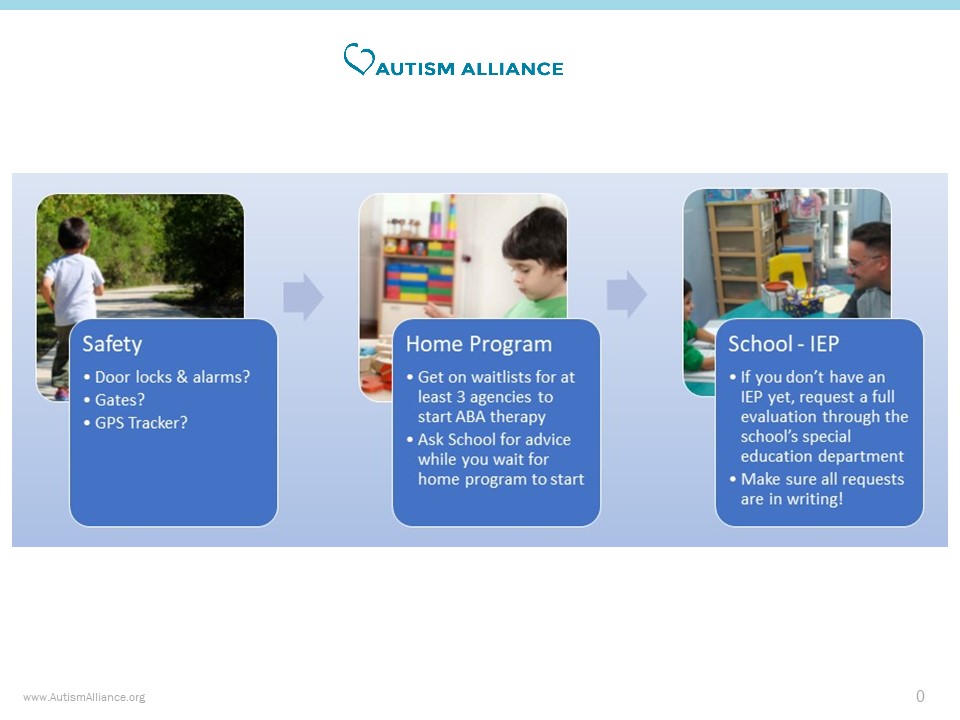Sign Up for Our Mailing List
Autism Welcoming Featured Partner
Check out our newest Autism Welcoming partner
Get Help
If you'd like to connect with Autism Alliance, reach out today.
Donate
Help support families caring for loved ones with autism.
Here are some helpful tips for caregivers:
- New Diagnosis
- Home Safety & Bolting
- Core Deficits
- High/Low Functioning
- How to Manage a Home Program
- Why Do You Use Visuals If My Child Can Talk?
- Talking to My Doctor About Medications
- Sibling Support
- SIB: Self-Inflicted Behaviors
- Self-Care for the Caregivers
- Transition to Adulthood
- SSI/Disability Income
- Employment
- Housing
- Guardianship
1. New Diagnosis

Whether you totally saw it coming or the diagnosis comes a total shock, it is never easy to be told your child has autism. Now that you have the diagnosis, you are probably overwhelmed and not sure where to begin. First, you want to make sure your child has the best IEP and service plan to help therapeutically address their needs.
Resources:
2. Home Safety & Bolting
Safety for every individual is a foremost concern. For individuals with ASD, especially children who are just beginning to work on life skills, bolting and childproofing are realistic concerns that affect the whole family. While baby-proofing your home is part of having a toddler, there are not as many mainstream methods to ensure safety of a growing person who is not yet able to inhibit their curiosity, impulses, or use of bolting as an escape behavior. There are some lesser known gems on the market that can give you peace of mind and help you create a safe space at home where you and your family can relax and be together.
Resources:
3. Core Deficits
A person with ASD has some or all of the following core deficits – parts of their lives that are more challenging for them than for people without ASD. The areas affected are sensory processing, emotional responses, social communication, as well as possible cognitive, medical, and/or psychiatric components.
Resources:
4. High / Low Functioning
People often refer to individuals with ASD and high language ability as “high-functioning” and those who have limited or no spoken language as “low-functioning”. As with anything, labels are not always helpful, especially once they get mixed up in social contexts. Clinically speaking, there are some terms including high and low functioning that can help indicate where an individual is working but even then, they don’t paint a full picture of who that individual is or what they are capable of doing.
Resources:
5. How to Manage a Home Program
When your home becomes a workplace for multiple people, it can feel like an ever-rotating cast of strangers, visitors, and friends who never leave. Here are some tips for being a professional boss that people love working for and ways to carve out your own privacy as well.
Resources:
6. Why Do You Use Visuals If My Child Can Talk?
Many parents have questioned why visual supports such as ASL, Boardmaker Icons, and picture schedules are used for children with verbal skills. Because verbal communication is the weakest form of communication with autism, using visual supports can help reduce frustration and increase competence while the child learns better ways for functional communication.
Resources:
7. Talking to My Doctor About Medications
There is no medication that can treat or fix autism as a disorder. There are, however, several medications often used by doctors and psychiatrists to treat some of the more disturbing or dangerous behaviors that are related to having autism. Behaviors that can be addressed with medication include but are not limited to depression, anxiety, obsessive compulsive behavior, self-injurious behavior, aggressive outbursts, or other coexisting mental health diagnosis. Medication can also be used to treat common medical problems associated with autism such as constipation, reflux, and sleep disorders.
Resources:
8. Sibling Support
Having a sibling with autism, whether younger or older, affects a child’s day to day life as much as if affects the parent’s lives if not more. The effects are not all bad and with good support, your neurotypical children can grow to be extra compassionate adults with a unique skill set for helping others.
Resources:
9. SIB: Self Inflicted Behaviors
Self-inflicted or self-injurious behaviors are common with individuals with ASD and they are among the more stressful and difficult behaviors for a caregiver to witness. Medications and behavioral therapy can help reduce their occurrence and severity. It may be helpful to understand why the behavior occurs in the first place. While there is no single answer that fits everyone, these are some common reasons.
Resources:
10. Self-Care for the Caregivers
You devote so much of your time and personal energy to taking the best care of your child with ASD, any other children you have, your family, maybe some pets, and probably everyone else except for YOU. Many adults today just weren’t taught that self-care mattered or that they had a right to take care of their own needs. Guess what, you have the right to taking care of YOURSELF. In order to be effective as a caregiver, it is so crucial that you take care of your own emotional needs first. Just like putting the oxygen mask on yourself first in case of a plane crash, you need to fill yourself up in order to keep on giving to others in your life. The struggle is HOW? How can you find the time and energy to invest in yourself?
Resources:
This Photo by Unknown Author is licensed under CC BY-NC-ND
11. Transition to Adulthood
When your child is old enough to finish school and potentially move out, everyone has questions and concerns. This is even greater when your child has autism. You may wonder what they will be able to do or you may know for certain that they will need many supports for the rest of their life. The best advice is – start early! You can request transition planning meetings to begin as early as age 12-14 but they must be a part of your child’s IEP starting by age 16.
Resources:
12. SSI / Disability Income
This is just a general overview of possible resources your child may be eligible for before and after reaching 18 years of age.
Resources:
13. Employment
People with autism are often excluded from the workforce or are underemployed. Here’s how to help your loved one.
Resources:
14. Housing
There are several options for your loved one and many facilities that can provide a home for them once they reach adulthood. From staying in the family home, living with other family caregivers, supported living or even independent living; there is a good fit for everyone!
Resources:
15. Guardianship
When it comes to legal decision making for your adult child, there are many points to consider. It’s best to start early and have a plan well before they turn 18. There are many ways to handle this, both formal and informal and it all depends on the needs of your individual child.
Resources:


